ME 262 JET FLIGHT TESTING BEGINS
Berlin, Germany · April 18, 1941
On this date in 1941 tests began of the world’s first operational turbojet fighter, the Messerschmitt 262 Swallow (Schwalbe). The tests were really of the airframe because the BMW turbojets were nowhere close to being ready. On July 18, 1942, a fully configured version flew—this almost nine months before the first flight of an Allied jet, the British Gloster Meteor. Three years later, on April 19, 1944, a test unit in Bavaria was set up to introduce the revolutionary aircraft into service and train a core of pilots to fly it.
The Allied response to the arrival of the Me 262, which flew at speeds of 560 mph, was to bomb the runways and factories where the planes were evident. This barrage, coupled with a fuel shortage, ensured that the Me 262, for all its technological superiority over the Allies’ piston aircraft, had limited success. That said, in March 1945 Me 262 fighter units were able for the first time to mount large-scale attacks on Allied bomber formations over Germany. On March 18, 1945, 37 Me 262s intercepted 1,221 Allied bombers and 632 escorting fighters, shooting down a dozen bombers and one fighter for the loss of three Me 262s. The Luftwaffe would have needed to sustain a 4‑to‑1 ratio to make any impact on the war’s outcome.
The British Meteor (top speed 410 mph/660 km/h) came into service about the same time as the Me 262 but suffered in comparison to its faster and better-armed rival. It had practically no impact on the outcome of the war, forbidden as it was to fly near continental Europe for fear that a downed jet might reveal design secrets to the enemy. Thus, Meteors were principally used to intercept the more than 8,000 jet-powered V‑1 buzz-bombs targeted on London.
During the closing months of the war, the world’s first tactical light jet bomber, the single-seat Arado Ar 234 Lightning (Blitz), entered service after project kickoff in late 1940. The Ar 234 had twin jet engines, flew at altitudes of 36,000 ft/10,973 m where it was impossible for Allied aircraft to intercept it, had a range of 1,240 miles/1,996 km, and was used mostly for reconnaissance. To reduce weight, the aircraft initially had no landing wheels; instead, after being launched on a three-wheeled trolley, it landed on skids. In April 1945 the Ar 234 was the last German aircraft to fly over Britain during the war, a bomber that never carried a bomb.
German and British Jet Aircraft of World War II
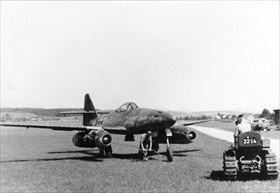 | 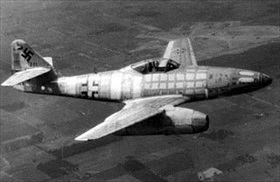 |
Left: The twin-engine Messerschmitt Me 262 Schwalbe was the world’s first operational jet-powered fighter aircraft. It was used in a variety of roles, including light bomber, reconnaissance, and even experimental night fighter. Roughly 1,400 Me 262s were produced. No more than 200 Me 262s were operational at one time, meaning their small numbers were incapable of influencing the Allied air campaign against Nazi Germany. Me 262s destroyed some 150 Allied planes (Me 262 pilots claimed a total of 542 Allied kills), but the Allies destroyed about 100 Me 262s in the air. In February and March 1945, Allied planes destroyed approximately 60 Me 262s in ground attacks.
![]()
Right: Pictured here was the first Me 262 to come into Allied hands when its test pilot defected in March 1945. It was subsequently lost in August 1946, the U.S. test pilot parachuting to safety.
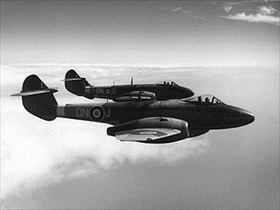 | 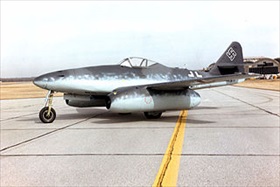 |
Left: The Gloster Meteor was initially used to counter the V‑1 flying bomb threat. Meteors accounted for 14 flying bombs kills, the first two on August 4, 1944. This was the first downing of one jet-powered aircraft by another. With the introduction of the ballistic V‑2 rocket, the RAF was forbidden to fly the Meteor on combat missions over German-held territory for fear of an aircraft being shot down and salvaged by the Germans.
![]()
Right: An Me 262A on display at the National Museum of the United States Air Force, Wright-Patterson Air Force Base, Dayton, Ohio.
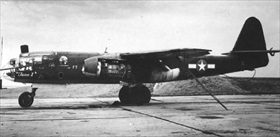 | 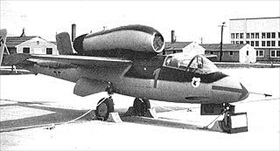 |
Left: Slightly faster but less famous than the Me 262 was the Arado Ar 234 Blitz, the world’s first operational jet-powered reconnaissance/bomber. Produced in very limited numbers (total production was 224 of all versions), the Ar 234 was used almost entirely in a reconnaissance role, but in its few uses as a bomber it proved to be nearly impossible to intercept. This photograph shows the Arado Ar 234B‑2 bomber with U.S. markings back in the States following its capture by British forces in Norway in 1945.
![]()
Right: A captured Heinkel He 162 Volksjaeger (People’s Fighter) parked at Freeman Field, Indiana, 1945. Made primarily of wood, the He 162 was a sleek single-engine, jet-powered fighter aircraft and was the fastest of the first-generation World War II jets. By war’s end on May 8, 1945, 120 He 162s had been delivered to the Luftwaffe. A further 200 had been completed and were awaiting collection or flight-testing, and about 600 more were in various stages of production.
Wings of the Luftwaffe: Messerschmitt Me 262 Schwalbe
![]()

 History buffs, there is good news! The Daily Chronicles of World War II is now available as an ebook for $4.99 on Amazon.com. Containing a year’s worth of dated entries from this website, the ebook brings the story of this tumultuous era to life in a compelling, authoritative, and succinct manner. Featuring inventive navigation aids, the ebook enables readers to instantly move forward or backward by month and date to different dated entries. Simple and elegant! Click
History buffs, there is good news! The Daily Chronicles of World War II is now available as an ebook for $4.99 on Amazon.com. Containing a year’s worth of dated entries from this website, the ebook brings the story of this tumultuous era to life in a compelling, authoritative, and succinct manner. Featuring inventive navigation aids, the ebook enables readers to instantly move forward or backward by month and date to different dated entries. Simple and elegant! Click 











